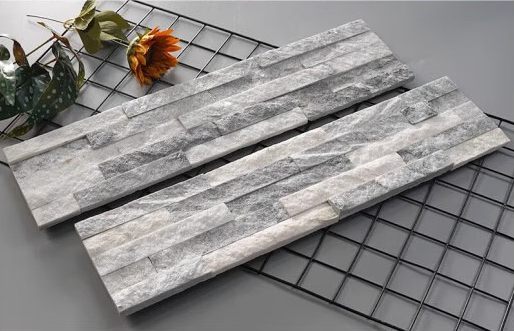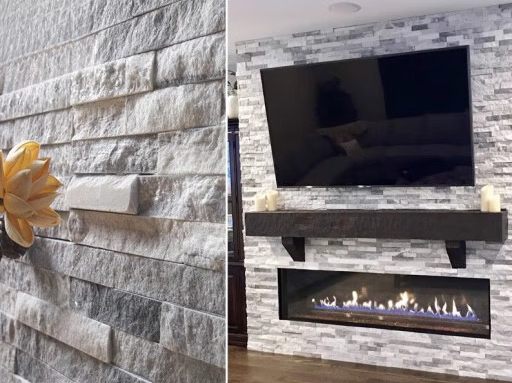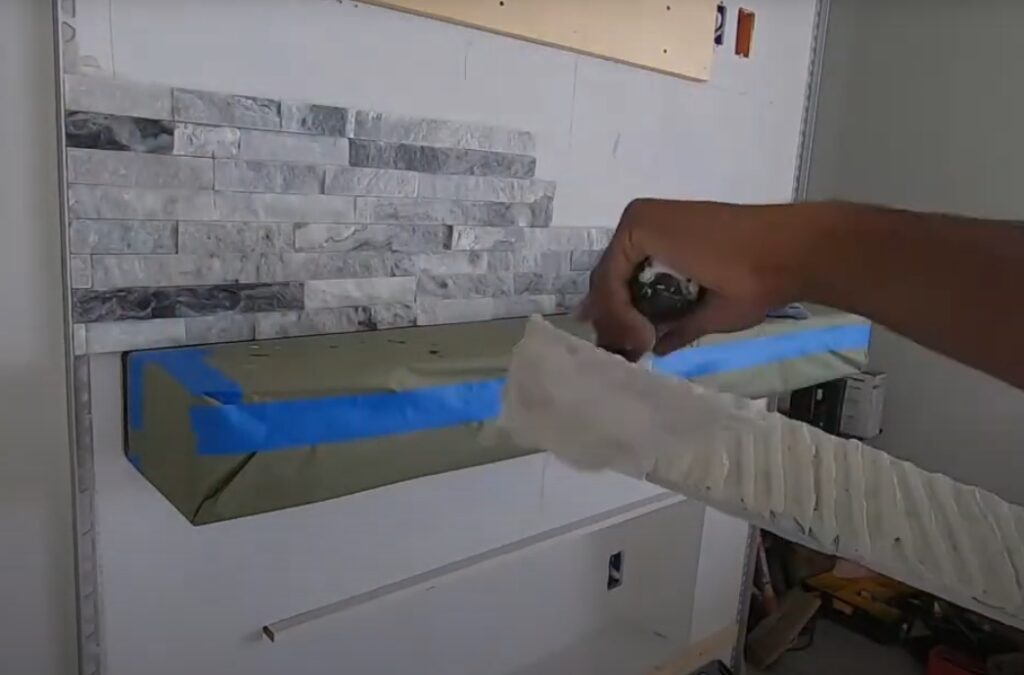Installing a stacked stone accent wall can feel complex when weighing design goals, durability, and budget realities. This guide outlines how to choose between natural and manufactured veneers, align finishes with modern, rustic, or industrial themes, and apply proven installation techniques. It also covers cost control and maintenance practices to ensure your wall makes a strong visual impact and delivers long-term performance in residential, commercial, or high-traffic spaces.
Why Stacked Stone Accent Walls Create Visual Impact
For B2B stakeholders — whether managing luxury residential builds or large commercial interiors — stacked stone accent walls deliver tangible design impact with enduring value. Their texture, depth, and placement flexibility make them a strategic asset for strengthening visual identity, enhancing property marketing, and meeting client expectations without overextending budgets.
Natural Texture and Depth
Stacked stone walls present a layered, rugged surface that interacts with natural and artificial light to produce dynamic shadow patterns throughout the day. This movement is difficult to replicate with flat finishes and immediately commands attention. That tactile dimension adds a premium feel without the cost of custom millwork, and selecting from rough-split to smooth-cut finishes allows precise alignment with client style preferences while keeping installation practical.
Timeless Aesthetic and Design Versatility
Stacked stone adapts seamlessly across design styles, from minimalist to rustic or industrial, reducing the risk of rapid trend obsolescence. In applications such as lobby feature walls or kitchen backdrops, it earns consistent positive feedback from clients with varied tastes. This adaptability means one material purchase can serve multiple property types and marketing strategies, and its ability to transform photographs of spaces can raise perceived value and accelerate sales cycles.
Flexible Placement and Enhanced Property Value
From living rooms and kitchens to reception areas and boutique retail, stacked stone adds character while offering durability and low upkeep. Property managers can present it as a premium upgrade during leasing or resale, using it to influence valuation discussions. Choosing stone that matches property positioning ensures market appeal without creating maintenance challenges.
Support for B2B Stakeholders Through Quality and Supply
Reliable sourcing is critical. Consistent stone quality, precise cutting, and a broad finish range keep installation schedules on track and avoid costly rework. Working with vendors who offer veneer options and clear substrate preparation guidance streamlines execution. For distributors, contractors, and designers, secure supply chains and rigorous quality control safeguard brand reputation and ensure every project delivers uniform visual and functional performance.

Material Options: Natural Stone vs. Manufactured vs. Faux Veneer
Selecting the right veneer for stacked stone accent walls requires more than visual appeal—it affects installation efficiency, durability, sourcing dependability, and ROI. The table below compares three primary material categories, helping procurement teams and designers align cost, performance, and longevity with project objectives.
| Material Type | Key Considerations for B2B Projects |
|---|---|
| Natural Stone Veneer | Cut from quarried stone for unique colors and textures without synthetic additives. Offers an authentic, premium aesthetic, high durability, and strong value appeal—ideal for high-end commercial or residential builds. Weight (~13 lbs/sq ft) requires skilled labor, solid substrates, and more installation time. Higher upfront cost is balanced by minimal long-term maintenance. Global quarry sourcing provides variety, but plan for freight logistics and longer lead times. |
| Manufactured Stone Veneer | Made from cement, aggregates, and pigments to replicate stone. Lighter weight cuts material costs by about 50% and speeds installation. Broad designs suit many interiors, but repetitive molds and limited color variation reduce realism. Cement may fade or chip over time and has lower sustainability—include maintenance budgets in cost planning. Readily available nationwide, suitable for budget-driven builds or straightforward installs on prepared drywall. |
| Faux Stone Veneer Panels | Lightweight polyurethane panels install quickly with minimal prep, making them ideal for temporary walls or low-traffic areas. Lowest cost option with simple handling fits short-term retail or event builds, not permanent installations. Appearance is less realistic and durability is limited—avoid for exterior or heavy-use environments. Supply is abundant with short lead times; deploy where replacement and visual trade-offs are acceptable. |
| Key Factors for B2B Material Selection | Prioritize ROI by balancing upfront and installation costs with market expectations. Account for maintenance, durability, and sustainability credentials. Secure dependable supply to prevent delays, and verify installation requirements—weight, substrate compatibility, labor skill, and speed—to meet project deadlines and resource planning. |
Design Styles: Modern, Rustic, Industrial & Contemporary Looks
Stacked stone accent walls can be tailored to project-specific aesthetics, enabling procurement teams to match finishes with design intent while meeting budget and installation priorities. Aligning panel style with architecture ensures visual cohesion and operational efficiency.
Modern Style
Modern spaces benefit from clean-lined, uniform-color stacked stone panels that deliver a sleek impact. A dry-stack installation eliminates grout lines, preserving minimalism and continuity—ideal for uncluttered layouts that highlight form over ornamentation. Panels like the Flat Series offer subtle texture that integrates seamlessly without overpowering other design elements, while consistent dimensions minimize trimming and keep labor hours in check.
Rustic Style
Rustic environments thrive on irregular stone shapes and natural variation. Panels with rough-cut faces and depth changes evoke traditional fieldstone, adding warmth and shadowed dimension. The Rough Series is effective for fireplaces or naturalistic facades, reinforcing authenticity and a nature-driven aesthetic. Procurement teams should confirm depth consistency across batches to maintain cohesion while preserving the organic character.
Industrial Style
Industrial interiors benefit from rugged textures and natural tones that complement exposed steel beams and concrete floors. A dry-stack configuration sustains the stone’s raw character and uninterrupted visual field. Robust profiles act as a visual anchor alongside heavy-duty materials, delivering tactile contrast in commercial lofts or converted warehouse spaces.

Contemporary Style
Contemporary design fuses modern precision with rustic warmth or industrial edge, using stacked stone’s variety in finishes and tones to craft distinctive compositions. Accent walls define spaces in open layouts without closing them off. Combining panels from different series or customizing finishes builds layered visual interest and delivers the sophistication clients expect, ensuring adaptability to evolving trends across residential and commercial projects.
Premium Ledger Stone for Inspiring Architectural Designs
Explore authentic, versatile ledger stone panels crafted for lasting beauty and easy installation. Elevate your projects with natural textures that offer strength, low maintenance, and design flexibility. Partner with us to access quality products and expert support tailored for distributors, contractors, and designers.

The Stone Guru’s Color & Texture Combinations for Your Space
Strategic pairing of color and texture is a decisive tool for shaping the mood, style, and market appeal of stacked stone accent walls. For B2B buyers, these choices influence how fast a project connects with its audience and how seamlessly materials fit into the design plan. The right combination moves an interior from functional to distinctive, while strengthening long-term asset value for clients and property owners.
Color Palettes for Different Design Goals
Stacked stone options range from Arctic Golden Panel and Calacatta Cressa in refined whites and grays to golds, creams, and complex multi‑tone blends that deliver strong visual impact. Neutral tones are a proven choice for broad market appeal, resonating across diverse property segments. Bold contrasts create immediate focal points, making them ideal for hospitality or retail interiors where first impressions drive engagement. For projects requiring fluid transitions between indoor and outdoor spaces, consistent palettes such as Calacatta Cressa maintain architectural continuity.
Texture Options and Their Effects
Texture drives the tactile and visual character of a wall. Split‑face panels provide a rugged, organic profile that reinforces authenticity in rustic or transitional settings, with surfaces that shift in depth and shadow throughout the day. Smooth or honed finishes keep lines clean for contemporary spaces, reinforcing minimalist schemes. Multi‑finish panels combine textures in one installation, adding layered sophistication without multiple orders — an efficient route to bespoke detailing in dining, living, or hospitality feature walls.
Tailoring Combinations to Space Function and Project Goals
Warm hues with pronounced texture define inviting zones in living areas, lounges, and around fireplaces, encouraging dwell time and reinforcing comfort. In contemporary layouts, smooth uniform stone maintains a tidy visual field, supporting open‑plan concepts without distraction. Soft creams and beiges with subtle variation bring understated elegance to bedrooms and dining rooms, appealing to buyers seeking comfort and refinement. Before finalizing, clarify whether the project demands wide resale appeal or high‑impact distinction — that decision ensures the material performs to its commercial or residential purpose.

Installation Step-by-Step: Substrate, Adhesive & Placement Techniques
Correct stacked stone wall installation hinges on precise execution at every stage—from substrate preparation to adhesive selection and panel placement. A disciplined process prevents costly failures, protects schedules, and delivers the intended design impact. For contractors and designers, this is where margins and timelines are won or lost.
Preparing the Substrate for Stacked Stone Installation
Clear the wall completely; dust, loose material, and moisture compromise adhesion. Use cement board or cement block for a stable foundation. Fix cement boards with backer board screws, fill joints with mortar, and embed mesh tape to create a smooth plane. Indoors over drywall, never attach stone directly—install cement board first to ensure the substrate supports weight without flexing.
Choosing and Applying the Right Adhesive
Mix thin‑set mortar in small batches to match your pace, following manufacturer ratios for bond strength. A professional‑grade product like ProLight stone mortar accelerates setting while securing stone firmly. Spread evenly with a notched trowel, press panels in with a gentle twist, and for lightweight or faux stone, consider high‑quality construction adhesive reinforced with fasteners in demanding installations. Work within the adhesive’s open time to avoid compromised bonds.
Placement Techniques for a Perfect Finish
Pre‑lay panels on the floor, blending textures and colors for a natural look and minimizing on‑wall changes. Snap a precise chalk line for the first course. Work from corners inward, stagger joints, and dry‑fit panels to catch sizing issues before bonding. Cut with a wet tile saw as needed, maintain level using shims, fill small gaps with textured caulk, and use touch‑up kits to conceal minor blemishes after install.
Managing Common Installation Challenges
Confirm substrate integrity before starting; weak spots lead to cracks or failures. Maintain level and alignment throughout with chalk lines and shims, and work steadily within adhesive open time. Sequence tasks to allow panels to cure undisturbed, preventing movement from other trades. This disciplined approach minimizes rework and ensures the finished wall meets structural and aesthetic standards.
Cost Breakdown: Materials + Labor for Full Walls
For procurement managers and contractors, understanding the real cost drivers of a stacked stone accent wall is essential for precise bids and profitable outcomes. Assess how materials and labor interplay, and account for extras early to avoid surprises. When margins are tight, detailed cost visibility enables sharper supplier negotiations and tighter site budget control.
Material Costs Overview
Material costs range from $10 to $39 per square foot, largely determined by stone type and grade. Basic piedra natural usually falls between $10–$20, offering authentic texture at controlled expense. Premium choices such as high-grade piedra natural or fieldstone can reach $32.50–$97.50, justified by superior durability and distinctive aesthetics. Manufactured veneer costs less, weighs less, and reduces structural reinforcement needs—speeding installation and lowering related expenses, which is advantageous for commercial projects with tight schedules or restricted access. The ideal material balances client design priorities with the building’s structural requirements.
Labor Costs Explained
Labor for straightforward installations typically averages $5–$26 per square foot, while intricate dry-stacking or specialty work can run $40–$104 per hour for skilled artisans. Interior walls are generally less costly than exterior due to easier access and fewer environmental challenges. Corners, transitions, and detailed substrate prep drive labor upward, so scope these accurately to avoid underestimation. Aligning labor skill levels with design complexity helps control spending while preserving finish standards.
Typical Total Project Costs and Additional Expenses
Combining materials and labor, most projects fall between $21 and $45 per square foot. Premium materials with advanced installation can exceed $75. For a wall of 220–235 square feet, expect $6,700–$10,800 before taxes, permitting, and markups. Extra costs often include contractor markups of 13%–22%, plus delivery, site prep, and cleanup. Treat these extras as fixed line items in your budget to protect margins, especially in multi-location builds or with third-party logistics.
Key Factors Influencing Cost
Material choice—natural versus manufactured and the quality tier—has the greatest impact on budget. Wall dimensions, elevation, and design detail significantly affect material volume and labor hours. High-end craftsmanship commands a premium but may be essential under strict client scrutiny. Difficult site access, demolition, or complex substrate work add time and cost, while permits, delivery logistics, and general contractor overhead further shape final pricing. Tracking these factors from the outset keeps design aligned with both vision and budget.

Maintenance & Longevity: Sealing & Cleaning Accent Walls
Stacked stone accent walls deliver lasting impact when supported by disciplined maintenance. Integrating sealing schedules, safe cleaning methods, and periodic inspections into ongoing upkeep protects both appearance and structural integrity. For installers, property managers, and designers, this proactive approach minimizes unplanned repairs and sustains project ROI.
Sealing for Protection and Longevity
Natural stacked stone can exceed a 50-year lifespan with minimal intervention, but applying a penetrating sealant every 3–5 years ensures resistance to moisture and staining. Penetrating sealants bond below the surface, blocking contaminants without altering the finish, and deliver up to 5 years of coverage per application. Manufactured stone veneer, with an expected lifespan of 20–50 years, depends heavily on seal quality and upkeep. In humid zones or freeze-thaw climates, sealing is critical to prevent water ingress that freezes and expands, causing cracks or spalling. For commercial or high-profile interiors, embed sealant applications into preventive maintenance to reduce the risk of costly wall rebuilds.
Cleaning Practices to Preserve Surface Integrity
Use a soft-bristle brush and mild detergent to remove dirt without scratching or etching the stone. Avoid harsh chemicals and high-pressure washing, which can weaken grout or erode softer stone types. Remove vegetation and debris promptly, as roots or trapped moisture can compromise adhesion or discolor surfaces. Regular gentle cleaning safeguards both aesthetics and structure, especially in hospitality or retail spaces where visual standards influence customer perception.
Routine Inspections and Early Repairs
Schedule inspections to identify cracks, loose segments, or moisture damage before they escalate into structural failure and costly intervention. Address detected issues immediately, and combine repairs with ongoing sealing and low-impact cleaning to maintain optimal performance and presentation. With quality installation and consistent upkeep, stacked stone accent walls continue to elevate property value and operational appeal for decades.
FAQs About Stacked Stone Accent Walls
Drawing on years of experience with stacked stone projects in residential and commercial settings, we’ve compiled clear, actionable answers to the most frequent questions from homeowners, designers, and contractors. The insights below focus on material choice, installation methods, accurate cost forecasting, and low-effort maintenance so you can plan and execute with confidence.
What’s the Best Material for an Accent Wall?
Natural stacked stone provides authentic texture and lasting durability that manufactured products can’t match. Slate brings a rich, layered look, quartzite delivers high strength with subtle shimmer, and marble adds refined elegance. Select based on location, desired visual style, and upkeep tolerance. For instance, marble in high-touch zones may require more frequent sealing, while quartzite in a foyer can handle heavy traffic with minimal maintenance.
Can I Install Stacked Stone Over Drywall?
Use a solid, load-bearing surface like cement backer board, concrete, or brick. Drywall alone lacks the strength for long-term support and can absorb moisture. If drywall is the only option, secure cementitious backer board first to create a stable base, prevent premature failure, and protect your investment in material and labor.
How Much Does a Full Stacked Stone Accent Wall Cost?
Pricing varies by stone type, wall size, and installation complexity. Premium natural stones command higher material costs, while lightweight interlocking panels can cut labor compared to full-thickness stone. Always factor in prep work, sealing, and finishing—skipping these raises the risk of early repairs, added expense, and project delays.
What Color Stacked Stone Works with My Décor?
Grays, beiges, and crisp whites suit modern, clean layouts, while warm earth tones enhance rustic or traditional spaces. Match stone color with surrounding materials and lighting—always test samples on-site before ordering. High-contrast shades make a wall a bold focal point, while softer palettes blend for a seamless, understated look.
Is Stacked Stone Accent Wall Maintenance Intensive?
When properly installed and sealed, natural stone needs little upkeep. Periodic sealing protects against stains and moisture, and routine cleaning with mild detergent preserves its appearance. Avoid harsh chemicals and pressure washing, which can damage the surface. Well-chosen stone will perform indoors or outdoors for decades with minimal maintenance.
Final Recommendations for Your Stacked Stone Accent Wall
A well-executed stacked stone accent wall creates lasting visual impact and can strengthen property value when you align material choice, reliable supply, and precise installation with clear design goals. Natural stone delivers authenticity and durability, manufactured veneer offers balanced cost and speed, and faux panels suit fast, low-traffic applications. Plan for both style and lifecycle—select texture, color, and placement to achieve practical elegance, prepare substrates meticulously, use proven adhesive methods, and maintain with routine sealing and gentle cleaning. For maximum ROI, invest in premium materials, match them strategically to your space, and engage installers who can deliver the finish your vision requires.

